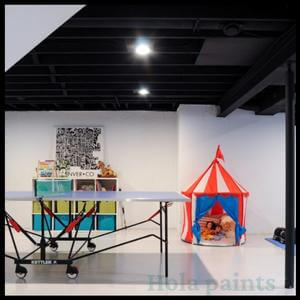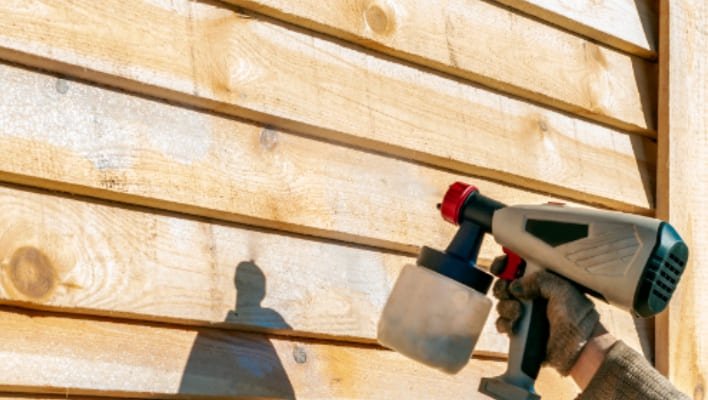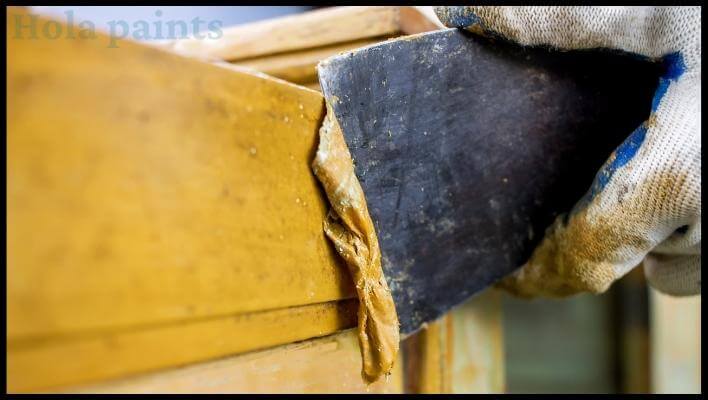Everything that is unfinished looks like a mess, and the same goes for the painting unfinished basement ceiling. It is one of the best ideas to paint an unfinished basement ceiling to make it look beautiful and elegant. Nowadays, painting the revealed basement ceiling with bright basement ceiling paint has become a trend. In a nutshell, it’s a simple process and DIY task leaving the wires or other stuff exposed.
If you are looking for the best ideas to paint an exposed ceiling, you are at the right spot. In this guide, we will cover all the details of the unfinished basement ceiling painting project and everything you need to know about it.

Table of Contents
- Can You Paint An Unfinished Basement Ceiling?
- Best way to paint an unfinished basement ceiling
- Painting basement ceiling by hand
- Spray painting unfinished basement ceiling
- How To Paint Unfinished Basement Ceiling
- Step 1: Check out The Pipes & Venting
- Step 2: Maintain The Pipes & Vents
- Step 3: Pull out The Ceiling Covering
- Step 4: Inspect & Bundle The Wiring
- Step 5: Cut The Additional Ceiling Nails
- Step 6: Clean
- Step 7: Cover The Areas with Painter’s Tape
- Step 8: Cushion The Floor
- Step 9: Protect Yourself
- Step 10: Apply Primer and Spray Paint
- How do you prepare an unfinished basement ceiling for painting?
- How Much Does It Cost To Paint An Unfinished Basement Ceiling?
- What Color To Paint Basement Ceiling?
- Pros and cons of painted basement ceiling
- Tips for painting an unfinished basement ceiling
- Final Verdict On Paint Unfinished Basement Ceiling
- FAQs On Paint Unfinished Basement Ceiling
- Is it OK to paint basement ceiling?
- Should I prime basement ceiling before painting?
- What kind of paint do you use to paint a basement ceiling?
Can You Paint An Unfinished Basement Ceiling?
It’s a common question people ask. Usually, people use drywall for painted basement ceiling or repair; that’s a totally traditional way. You should not just think of painting your basement ceiling, but also think of making it look elegant and attractive. The reason is that it has a great impact on your overall basement space.
Take painting basement ceiling as a DIY task and try to cover all the items via paint, such as pipes, cracks, copper pipes, soft pipes, PVC pipes, and even ducts. Here choose a material-friendly paint to ensure long-term sticking. You can also take help from the instructions guides for the right paint selection.
Check out this helpful resource to learn how to paint ceiling tiles!
Best way to paint an unfinished basement ceiling

Basement painting is today’s significant trend in every house. In general, you can either paint ceilings by hand using a brush or roller, or by using a spray gun.
Painting a ceiling with a spray gun is the fastest and easiest method. However, painting ceilings by hand is more economical.
Painting basement ceiling by hand
You can use a brush or roller for painting basement ceiling by hand. This work will take quite some time.
In comparison to covering the rafters, pipes, and ducts, painting a flat ceiling takes 10 times longer. A rough surface might also require multiple coats of paint.
Spray painting unfinished basement ceiling
You should spray paint the ceiling if your house has many wires, pipes, and nooks and crannies. Using a spray gun to apply paint creates a smooth, consistent finish.
In addition, the process takes significantly less time. There’s no need to constantly refill your paint bucket with a sprayer or hold the roller over your head. A basement can be sprayed in a few hours while a ceiling by brush takes days.
Another benefit of using a spray gun is being able to use fewer coats of paint. When you’re finished, apply a few touch-ups with a brush and a roller to fix any drips that may occur. If not, you’ll need a second coat to cover drips or other imperfections.
If you do not yet have a paint sprayer, then read our post about the high quality paint sprayers for ceilings.
How To Paint Unfinished Basement Ceiling

If you have decided to paint the basement ceiling, first, collect all the necessary materials such as a paint sprayer, paint’s tape, paint, etc.
You can also perform painting basement ceiling by hand if you don’t want to spend on a paint sprayer. After all, follow the below-mentioned steps to get a painted unfinished basement ceiling.
Step 1: Check out The Pipes & Venting
The basement of any house or building consists of some sort of pipes and vents. Always inspect them carefully.
Analyze the material type and choose the paint accordingly to get a sticky and long-lasting finish after sprayed basement ceiling.
Step 2: Maintain The Pipes & Vents
After inspecting the pipes and vents, the next step is maintenance. Make them secure, fill the cracks if found, and tighten the loose vents. Simply adjust them without breaking them out. You can buy some hangers and wires to attach pipes and hang them into the ceiling to make them more secure.
Step 3: Pull out The Ceiling Covering
The paint basement ceiling always includes some kind of isolation known as insulation. It’s time to detach it completely. Basically, it’s an optional step but removing it gives you better results. If you are not removing it, check the gaps or cracks in the insulation and fill them properly. Trim down the extra cover with the help of a blade to make the painting unfinished basement smooth and balanced.
Step 4: Inspect & Bundle The Wiring
The basement ceiling also consists of wires that mess with each other in different directions. The best way to protect them is to tie them with tie cables and painted rafters in basement. You can also use tape for it depending on your needs and requirements. Make small bundles of wires, staple them, and check whether they look organized or not. Make sure your job looks cleaner and safe while painting a basement ceiling exposed ductwork etc.
Step 5: Cut The Additional Ceiling Nails
If it’s not your first-time basement job, there might be falling paint on the floor. For it, buy a Dremel and snip all the ceiling nails. After that, trash the residue, or you can clean the floor with the help of water. It’s an extra safety tip to avoid sharp nails and residue.
Step 6: Clean
Pick up the scrub brush, broom, or ShopVac and clean the whole ceiling properly and carefully. It helps you remove dirt, dust, and all the stick debris to make your painting job better. To remove cobwebs, you can use a vacuum cleaner or dusting stick. If the basement has extreme levels of dirt, you can use an air compressor. It will blow the air, and all the dust will blast away. It’s a hard-working process, but you get the best cleaning results.
Step 7: Cover The Areas with Painter’s Tape
Not all the parts of the ceiling need paint, and it’s important to cover such areas. A painter’s tape helps you cover such areas such as windows, doorways, light fixtures, and more. Tape off the electrical outlets, electrical boards, junction boxes, furnace, shut-off knobs, and such hardware.
Step 8: Cushion The Floor
Before starting your painting job, take care of the floor and try to minimize the mess. The droplets fall on the floor, which makes it dirty and unclean. Therefore, always use contractor’s paper, drop cloths, and other wiping cloths to protect the floor. Cover everything on the floor that you can’t remove after finishing the painting job, such as floor lights, etc.
Step 9: Protect Yourself
Not only the floor, but you also need to protect yourself from spray while painting through a spray gun. Always wear painting goggles and side covers to protect sensitive organs such as the eyes. Cover your head; otherwise, the paint may sock, ruining your hair.
A face mask is a necessary safety material to protect your lungs from the fumes that may cause serious irritation. It protects not only your lungs but also the mount cavity and throat. Last but not least, protect your hands by wearing high-quality gloves.
Step 10: Apply Primer and Spray Paint
This is the meantime, and you have to apply primer to the pipes, rafters, ductwork, wires, etc. Here you can also make a contrast for each item, such as black color for wires, white color for pipes, and silver color for metal pipes. Just make sure you have selected the paint or primer according to the given instructions.
Try to cover everything and adjust sprayer speed & distance for an even paint finish. After that, clean the brushes, spray gun, and rollers with the help of ammonia solution.
Finally, start applying the paint. Here the primer helps use less amount of paint to decrease the overall painting cost. Try to use brushes, rollers, and spray gun to cover all the areas carefully and properly. Don’t apply the second coat immediately; wait about an hour before applying.

How do you prepare an unfinished basement ceiling for painting?
The preparation involved buying the necessary tools, paint, primer, and other items. After that, you have to clean the insulation if the ceiling has. Cut the extra parts, repair the insulation cracks, and clean it. After that, cut the nails and dripped off the dry paint with the help of special tools.
Next, bundle up the wires and pipes to make asymmetry. Now, cover the areas and items you don’t want to paint, such as windows, lighting fixtures, etc. Lastly, cover yourself and the floor before starting the painting project.
How Much Does It Cost To Paint An Unfinished Basement Ceiling?
It is a common question people ask online, i.e. cost to paint basement ceiling. It usually depends on many factors such as paint type, primer quality, paint & primer brand, tools, ceiling size, number of coats, and more. However, here we can give you an estimate if you want to perform this job by yourself.
Normally, an unfinished basement ceiling painting costs about $1-$3 per square foot. This cost includes the spray gun and other necessary tools.
What Color To Paint Basement Ceiling?
You are free to choose any color to paint the basement ceiling. However, the question still remains: Which is the best color for the basement ceiling? Here we want to give you the best ideas for basement ceiling color.
White color is one of the best colors for basement ceiling because it looks brighter and you need less number of lighting fixtures. In contrast, it requires at least two coats, increasing the budget, and might turn yellow with time.
In addition, painted grey seems a good choice for basement ceiling because it’s a compromise between light and dark colors. It looks cool and helps hide many cracks and other details. Lastly, you can go for black painting basement ceiling if you like bold or dark colors. Nevertheless, you need to increase the lighting in the basement if you choose black.
Pros and cons of painted basement ceiling
If you think painting the basement ceiling is not an important investment, check out the significant advantages and disadvantages of painting the exposed basement ceiling in the following:
PROS:
CONS:
Tips for painting an unfinished basement ceiling
The following are some last tips for painting a basement ceiling:
- Protect yourself from harmful chemicals.
- Taping the room will take longer than painting it with a spray gun.
- Invest in an airless paint sprayer.
- You can purchase five-gallon paint cans as a cost-effective option.
- Using black paint gives better coverage.
- Use white paint to lighten up a dark basement
- It is best to paint the entire area in one day. This includes the ceiling, walls, ductwork, pipes, and cords.
- The blue painter’s tape does not stick to concrete.
Final Verdict On Paint Unfinished Basement Ceiling
In conclusion, painting an exposed ceiling is now a great trend, and many people like painted unfinished basement due to several benefits. There are many ways to paint the basement, but we have shared the crucial steps that are applicable to all types of basement ceilings. The design, tools, and other requirements depend on your space and what you want to achieve. We hope you will find this guide and the best way to paint an unfinished basement ceiling helpful in getting a good basement ceiling paint finish.
FAQs On Paint Unfinished Basement Ceiling
Is it OK to paint basement ceiling?
In our opinion and experience, it is perfectly fine to paint your basement ceiling. It not only protects the insulation and ceiling but also gives the basement a new and elegant look. You can also make beautiful contrasts with the walls of the basement.
Should I prime basement ceiling before painting?
All the expert painters always recommend using a primer before painting the basement ceiling. It allows the paint to stick perfectly and easily on the surface. It also reduces paint consumption and gives a smooth finish to everything. You can use exposed basement ceiling painted white or exposed basement ceiling painted black.
What kind of paint do you use to paint a basement ceiling?
There are a lot of options available for basement ceiling paint, but we recommend you go for latex or sprayable paints for it. They can be easily applied to ducts, pipes, wires, and give the best painting results according to your needs and requirements.

Jennifer Marie
Jennifer Marie is a general contractor with over the years of experience in home remodeling, DIY projects, and commercial painting projects. Her experience includes working with paint sprayers, painting tools, and other painting supplies. You can follow her on Facebook.


